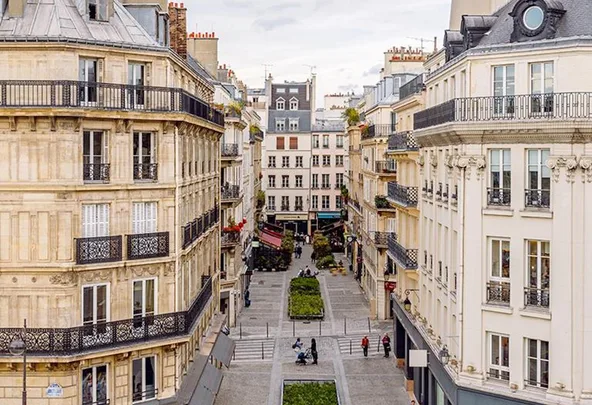Paris might be the fashion capital of the world, but it has a less glamorous title: it’s one of Europe’s most congested cities. For the fashion crowd, never is this more evident than during the twice-yearly Paris Fashion Weeks. Darting between shows and battling with bumper-to-bumper traffic highlights what masses of vehicles do to a city not designed for them. Dior might delay its F/W 22 show by 40 minutes waiting for Rihanna to show up, but they won’t wait for you just because you’re stuck in traffic.

Fashion and congestion are more closely related than you might think. Online shopping, which ballooned during the pandemic, is on track to hit 260 billion packages delivered worldwide by 2026. And as online shopping increases, so too do the number of trucks on our roads. More deliveries equals more congestion and more emissions.
It’s a delivery problem cities, organisations and companies around the world are trying to fix. That includes Uber, which commissioned a report from engineering services firm WSP on this exact issue. The answer? According to Uber, it’s ‘micromobility’—and the company is hardly alone in this line of thinking.
Micromobility is essentially an umbrella term for lightweight vehicles: bikes, e-bikes, cargo bikes, scooters, and potentially even drones. Uber sees a future where the last leg of a delivery journey—also known as the ‘last mile’—is completed not by a delivery truck, but by a micromobility vehicle.
“Uber can’t do this by ourselves,” Lucas Groeneveld, Regional General Manager Retail ANZ at Uber Eats, told marie claire Australia. “We can make the investments we’ve made in safety and technology and education, but we can’t pave the roads with bike lanes and infrastructure. And we can’t single-handedly shift the way that cities think about mobility.”

That would require a holistic response from all levels of government as well as local businesses: yes, you need more bike lanes, but you also need local stores to adapt to a new delivery environment.
However, the report claims the benefits are enormous, somehow managing to help tackle the climate crisis, create jobs, and improve the health of cities to boot. In fact, it lays out 10 key opportunities, drawing on real-world examples to make its point.
Global warming? Norway’s postal service reported a 40% decrease in Olso’s CO2 footprint when it trialed a combination of micromobility and electric vans. Health? Utrecht in the Netherlands reported savings of $300 million annually thanks to reduced air pollution and health care costs after it reduced speed limits to 30 km/h in built-up areas to make cycling safer. And safety? Finland’s capital of Helsinki, where 9% of all trips are made by bike and which boasts 1,300km of cycling routes, recorded zero deaths of people walking and cycling in 2019, a first in almost 70 years.
“There is a lot of Australians who can learn from the research and data from the ten cities examined in the Future of Delivery Report,” Groeneveld said. “Firstly, ensuring we all work together to make it safer for people to cycle in cities, by changing the built environment to facilitate safe and easy pick-up and drop-off from the kerb. And secondly, setting long-term policies that support a transition from cars, trucks and vans to micromobility for last mile deliveries, promoting a more sustainable option.”
We could be looking at a future fashion world where a dress is delivered to you in the same way a burrito bowl is: via an app, in a short time frame, and by a local delivery rider on a bike.
“As this last mile freight task grows, we all have a responsibility to make sure delivery workers are kept safe, and that we are not adding to traffic congestion or vehicle emissions,” the Business Council of Australia CEO Jennifer Westacott said in a statement.
“This work from Uber highlights some of the thinking emerging from the business community to help address these very issues.”
And as for Paris? No city in the world is as primed to adapt to a micromobility future. Already, 100% of Uber deliveries in the city are completed via two wheels (e.g. bikes, motorbikes and scooters). France is investing €250 million (approximately $270 AUD) to make the city entirely bikeable by 2026, and Paris will ban the majority of cars in the central areas (the 1st, 2nd, 3rd and 4th arrondissements) from 2024.
Paris Fashion Week Spring / Summer 2024 might look very, very different. Instead of fighting for Ubers between shows, could the fashion crowd hop on an electric scooter instead? If the net benefits of a micromobility future are to be believed, then we have one word for it: allons-y.
Disclosure: the author travelled to Paris for the unveiling of this report with Uber.










